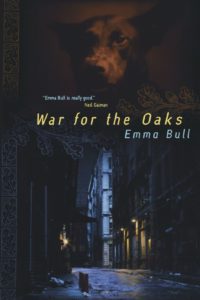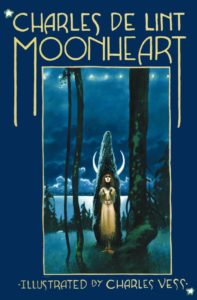Until the 1980’s, magic generally occurred in invented worlds, fantasy based itself on pastoral settings, or extrapolations of various time points in (generally) Western history. In the 1980’s though, with Charles de Lint’s Moonheart and Emma Bull’s War for the Oaks, fantasy moved into town, magic invaded cities and suburbs, and fairy oaks sprouted in urban sidewalk cracks. From its beginning, urban fantasy has been dominated by the female hero, and their journey on the Hero’s Quest.
John Clute and John Grant defined urban fantasy as “texts where fantasy and the mundane world interact, intersect, and interweave throughout a tale which is significantly about a real city.”
It’s almost a tie with which urban fantasy is the first — good arguments can be made both for Moonheart and War for the Oaks. I’m starting with War for the Oaks, because de Lint’s Newford, although a typical city, is purely imaginary, while Minneapolis, Minnesota, is, well, real. (Don’t worry — this is only one column of three — I’ll talk about Charles de Lint next month, and Laurell K. Hamilton will round out this trilogy.)
There’s common elements inherent in Urban Fantasy besides just the city, although urbanity and magic must be involved, the Personality is also paramount. In urban fantasy, more often then not, the Personality is a contemporary woman, a second-wave feminist, navigating multiple worlds, both the mundane and the fantastic. Particularly in Urban Fantasy, the heroine is battling for not just the right to vote, but to be seen as equal both legally and societally, fighting for an equal footing in the power politics of sex.
In War for the Oaks (1987), Emma Bull created Eddi McCandry, a struggling rock star coerced into the age old conflict between good and evil, fighting to form her band while facing the evil forces of the Unseelie Court and falling in love with a Phouka (a deliciously sexy cross between Bowie and Prince).

Can you spot any wandering fey warriors? Image © tripsavvy.com
Unlike deLint’s Newford, the environment and locations Emma Bull uses are set firmly in Minneapolis – the Nicollet Mall chase, the Fey battle at Minnehaha Falls, and climatic playoff for the fate of the city at the Minneapolis College of Art and Design.
However, the draw and lasting power of War for the Oaks lies not only in its settings and the use of magic, but also in the lure of Eddi McCandry and her struggles, particularly her fraught romance with the fairy Phouka. Eddi is struggling in all worlds, and her journey on the feminine version of The Hero’s Quest is deeply satisfying. Although the strong urban fantasy female protagonist is almost a trope today, Eddi McCandry blazed the path for the flood of strong women to follow, as the colonization of the fantastic map moved into the cities.



I didn’t read War for the Oaks until last year but I really enjoyed it. Given the Minneapolis setting, I did find myself wishing that Prince could have been a character in the story.
I pretty much decided the Phouka was Prince, grin.
[…] two of three on the genesis of Urban Fantasy and the colonization of the cities by the fantastic. Part 1 covered Emma Bull and her seminal novel, The War for the […]
[…] look at urban fantasy. After covering Emma Bull’s game-changing The War for the Oaks in part one, this leg of the journey examines the work of Charles de Lint and his ubiquitous town of Newford, […]